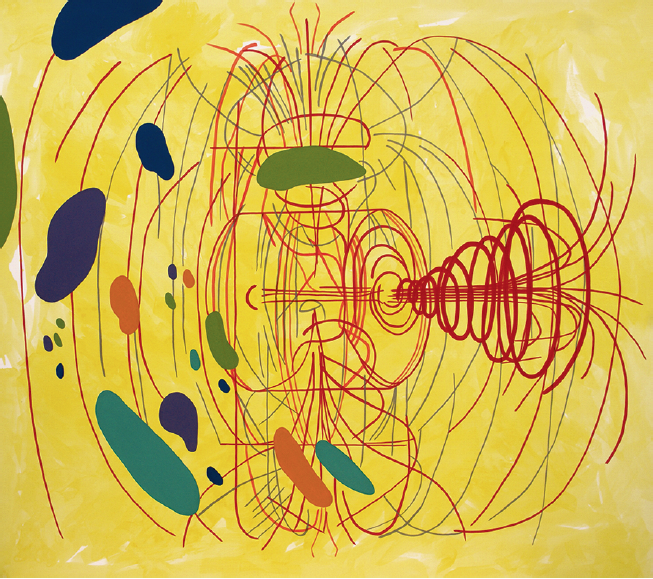Sandra Meigs with Christopher Butterfield
“I don’t get it, but I like it,” exclaimed a young woman inside Sandra Meigs’s exhibition “Room for Mystics” at the Art Gallery of Ontario. What might sound like a remark coming from a viewer untrained in the game of decoding art is actually what Meigs and her collaborator, composer Christopher Butterfield, wanted. The immersive installation is meant to stimulate states of feeling rather than offer concepts about the world. It is a playful, introspective space, akin to the practice of what Heidegger called “meditative thinking” opposed to analytic understanding. Here, the experimentation of feeling takes over from the knowledge of meaning.
Nearly every inch of the room is saturated with colour and sound. Massive white banners with painted yellow spirals cover the walls. The floor space contains A frames of large paintings paired up and leaning on one another. A loudspeaker accompanies each pair, emitting a tone taken from the partials of F sharp, the resonant frequency of the gallery itself. Arranged by Butterfield using chance operations, the tones change gradually and produce a continuous but varied chorus. Stools are available to sit on, and an enormous mobile, twirling languidly in the cavernous space below the skylight, depicts a pair of stylized, closed eyes and a smiling mouth. There is too much of the spectacle to take in at once. Yet, as viewers navigate around the tent-like paintings, the calming hum of the musical tones fills the air like a never-ending “om” chant.

Sandra Meigs, Room for Mystics, No. 7, 2016, acrylic on canvas, 182.9 x 147.3 cm. Collection of Michael and Carla Perry. © Sandra Meigs. All images courtesy the Art Gallery of Ontario, Toronto.
Chanting is contagious. I had the sound of the tones buzzing in my head for about 20 minutes after leaving the installation. In religious practices, the act of chanting synchronizes worshippers, elevating them from an individual existence to a higher level of collective spirituality. In a very physical sense, the same frequency humming inside many people unites them. In this room, the viewer becomes one of the worshippers, amid the cast of A-framed paintings emerging like praying hands from the gallery floor. The imagery in the paintings also references the reaching of higher states of consciousness. Several paintings depict simplified figures meditating, sitting with eyes closed, floating in deep space, or with spirals of energy shooting from their heads. Cosmic motifs like galaxies, orbs, discs and saucers recur in the paintings, often stretched or flattened to create optical play between flatness and three-dimensionality on the canvas.
Rather than relying on preexisting spiritual iconography, Meigs constructs her own wacky cast of symbols. Visible from everywhere in the gallery, the smiling mobile provides spiritual reassurance, like a simplified emoji-like Buddha floating contentedly in space. Several paintings feature the same face, its mouth occasionally forming into an even bigger, happier smile. Partly autobiographical of Meigs’s own experience with meditation, the exhibition provides the visual and aural setting for viewers to enter their own meditative states. But none of this is to be taken too seriously. Painted simply with bright colours and childlike frivolity, the room avoids being heavy-handed, prescriptive or didactic.
The symbol of the vortex caught Meigs’s interest while she was sketching the architecture of mansions. Sitting near the spiral staircase, she felt its pulling action as if it were beckoning her to become one with the house or to travel along its curving arms into another universe. In “Room for Mystics,” we can imagine getting sucked into the massive yellow spirals on the gallery walls, being pulled beyond those walls into atmospheric and galactic space.

Installation view, “Room for Mystics,” 2017, Art Gallery of Ontario, Toronto.
Vortices are one of those phenomena that draw an undisputed connection between what happens on earth and what transpires deeper in the cosmos. The swirl of milk in your coffee cup follows the same laws of fluid dynamics as the cloud vortex at the north pole of Saturn or the dust devils on Mars. At the centre of each of these vortices exists a core region of relative calm where particle speed stops increasing. This is what we call, colloquially, the “eye of the storm.” With its calming tones and painted vortices of many sizes, “Room for Mystics” functions as both a representation of fractals and an eerily calm vortex centre.
The installation’s slow-moving soundscape and focus on meditation links the exhibition to minimalist composers like John Cage and Giacinto Scelsi, as well as artists like Bill Viola and some members of the Fluxus group, all of whom were influenced by Eastern philosophy. Some political configurations of the late 20th century seem to be re-emerging today as well. Deep mistrust of Russia, threat of nuclear annihilation and a scandal-ridden White House make it seem as though the world may have just travelled backwards along a malevolent, regressive vortex. Yet, these fearridden conflicts remind us of the high cost of conceiving reality as fragmented rather than whole. A possible solution offered up by Meigs and Butterfield in “Room for Mystics” is a kind of thinking that is hungry for connections, between the miniscule and the cosmic, the individual and the collective, the playful and the dead serious. ❚
“Room for Mystics (with Christopher Butterfield)” was exhibited at the Art Gallery of Ontario, Toronto, from October 19, 2017, to January 14, 2018.
Anna Kovler is an artist and writer living in Toronto.

